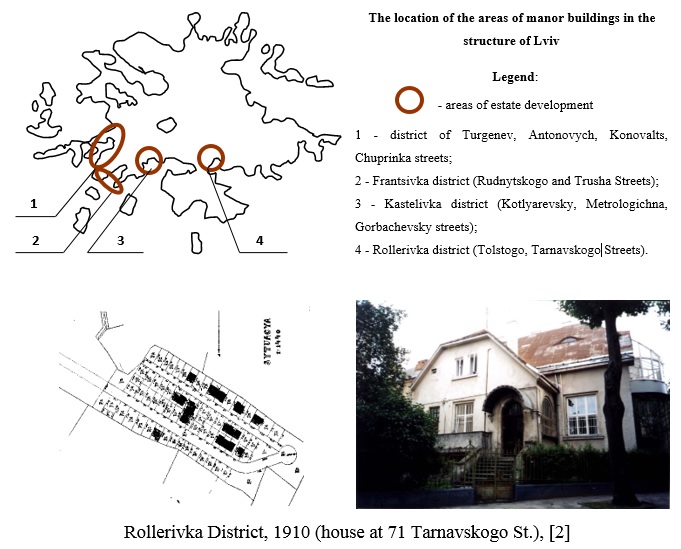Lviv was divided into some individual districts before. That’s why it is important to compare the relevant data regarding them. The names of districts came from the former suburbs that were located around the closed city. In total, in 1900-1926 there were five precincts: I – Halytska, II – Krakivska, III – Zhovkivska, IV – Lychakivska, V – Sredmistya.
The census from 1.V.1926 covers the number of existing houses (5,868) and the inhabitants who maintain them (49,628), without showing the number of inhabited houses, and the census of 1921 shows that Lviv has 7,037 houses, incl. residential - 6895.
The peak of construction activity was in the summers in 1911-1912. The growth of houses in this period is greater than the growth of the population (the second one was 51.73%). Taking into account only occupied houses, this percentage will increase to 57.20% [1]. However, this growth was not the same for all years. Despite a fairly significant construction movement, in 1900-1910 the growth of the number of houses was 22.36% and it was smaller than the population growth (28.92%). In 1910-1921, the number of houses increased by 27.80%, and this growth should be attributed to the three pre-war years – 1911, 1912 and 1913.
If we look at the number of houses in different precincts, we will see that the largest number of houses was in I precinct (2,292), and the least was in V precinct (351). In 1900-1910, the largest growth of houses was also in the 1st district, where it was 33.52%, the lowest in the 3rd (9.11%), and in the 5th district, the decline in growth was 5.17%. In the following period, the greatest growth of houses was observed in the 4th district (34.78%) and in the city center, where it was 12.50%. In general, in 1900-1921, I precinct showed the greatest increase (66.69%), followed by II precinct (64.06%) and precinct number IV (61.42%), and the smallest increase was in the city center (6.69%). It should be noted that the number of unoccupied houses decreased by 11 in 1910 compared to 1900, and by 8 in 1921. With the increase in population, the number of people holding houses was greater by 17,402 in 1926, or 54% more than in 1900. In 1900, there were 4.64 people per party (housekeepers), in 1910 – 4.63, in 1921 – 4.46, and in 1926 – 4.61.
We get an important picture of the population of the city by comparing the number of houses with the number of residents. In 1900, there were 34.3 inhabitants per house, in 1910 – 36.5, and in 1921 – 32.0 inhabitants (Fig. 1).

Fig. 1. Localization of the areas of manor buildings in Lviv during the modern period (end of the 19th century – 1914).
In 1921, the III precinct (38.6) was the most densely populated, followed by the II (38.5), V (34.9), IV (26.4), and I (25.9) precincts [3]. These data indicate that the number of residents living in the same house was decreasing. This meant that low-rise housing gained a significant share in residential construction as a whole. Data on population density shows that the development of manor houses took place in first (Halytskyi) and fourth (Lychakivskyi) districts. These data coincide with the data of field survey.
Residential relationships can be estimated from the number of rooms in apartments and the number of people in them. So, 32% of all apartments in Lviv were one-room apartments, 63% in Łódź, 54% in Częstochowa, 48% in Lublin, and 10% in Bydgoszcz. 7% of all apartments in Lviv had five or more rooms, 3% each in Łódź, Sosnov, Lublin, and Częstochowa, and 16% in Poznań [4].
In Lviv, 27% of the population lived in one-room apartments, 64% in two-, three-, and four-room apartments, and 9% in five-room or more apartments. There were 1.8 inhabitants per room in Lviv, 1.7 in Volyn cities, 1.9 in Galician cities, and 2.4 inhabitants in Łódź, Częstochowa, Sosno and Lublin. So, these residential relations show that Lviv developed not exactly as an industrial city, but mainly as a city of intellectual work, since the development of industry causes the concentration of a large number of workers in the city, and, accordingly, increases the average number of residents per room.
References
1. Hoszowski S. Ekonomiczny rozwój Lwowa w latach 1772-1914 – Lwów: Nakladem izby pzemyslowo-handlowey, 1935. – S. 62, 63.
2. ДАЛО, будинок на вул. Тарнавського, 71, ф. 2, оп. 2, спр. 6356.
3. Pazyra S. Ludność Lwowa w pierwszej ćwierci XX w. – Lwów, 1931. – S. 421.
4. Львів у цифрах. – Львів: Накладом української католицької організації, 1938. – С. 4.
|








